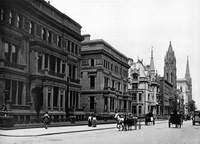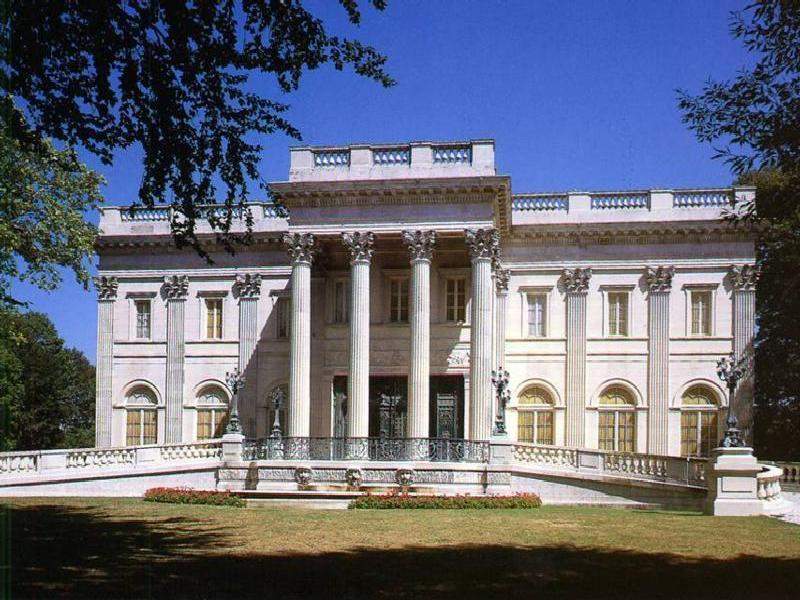|
William Kissam Vanderbilt's
"Marble House", Newport
R.I
1888
Richard Morris Hunt,
architect
Jpg: Excite image search
Under Construction
notes
William Kissam Vanderbilt left a fortune of $ 55 million, mostly to
his two sons, William Kissam
Vanderbilt jr and Harold Stirling Vanderbilt, having given his
daughter Consuelo the amount of $ 15 million a little earlier.
The first of Willam Kissam and Alvah Vanderbilt's three children
and their only daughter, Consuelo
Vanderbilt (1877-1964) was the main actor in a society drama
which epitomized the spirit of the Gilded Age
…
******
ALVA
ERSKINE SMITH (William Kissam Vanderbilt, )
"In 1874 she married William Kissam Vanderbilt, the second son of William
H. Vanderbilt, owner of the Grand Central Railroad. Her brother in law,
Cornelius was slated to inherit the entire Vanderbilt fortune, according
to the eldest son tradition of the era. But, she influenced her father
in law by persistent praise of the abilities of her husband, to divide
the fortune more equitably. She taught the Vanderbilt family how to spend
their fortune by building mansions and palaces to live in the style of
European royalty, which they could well afford. In 1879 her fancy dress
ball for the grand opening of 660 Fifth Avenue, the French chateau designed
by Alva and Richard Morris Hunt to outshine anything in the neighborhood,
brought the Vanderbilts into New York/Newport society, so long guarded
by Mrs. Astor and the Old Family Knickerbockers. She raised three children:
William Kissam, Jr. (Willie K.), Consuelo, and Harold Stirling. Her social
position was at its height in the 1880s, when rumors of the attentions
of Oliver Belmont began. At this time in Newport the great mansion-building
era, the gilded age, was beginning and William K. Vanderbilt, at Alva's
instigation, purchased the land abutting THE Mrs. Astor's "Beechwood" to
build "The Marble Palace" as another challenge to Mrs. Astor, still leader
in Newport society. Begun in 1888 with Richard Morris Hunt the architect,
Marble Palace was completed in 1892, and lured many young European noble
bachelors as well as all the wealthy sons of the American "Royalty" to
catch a suitable husband for Consuelo. Mrs. Vanderbilt negotiated tirelessly
to arrange the best alliance by lavish entertaining, grand balls and parties,
tea dances and small private dinner parties ending late in 1895 with the
marriage ceremonies and celebrations in New York, Newport and London celebrating
the union of Consuelo to the 23-year old Ninth Duke of Marlborough."
**********

Duke
of Marlborough Family
(9th
Duke)
1905
Duke
of Malborough collection,
Blenheim
Palace
Oxfordshire,
England
Oil
on canvas
332.7
x 238.8 cm (131 x 94 in.)
*****
Eisenberg
"The cash broke royalty from euourpe that came over trying to
marry Consuelo was astoundinly discussting. Prince Leopold of (E) Isenberg
from the Imperial courts of Austria "It appears that the (E)Isenbergs were
mortgaged to the limit, when young Prince Leopold started for America with
borrowed money to attack the hearts of American heiresses, notably that
of Consuelo Vanderbilt, who was singled out as the richest plum to be plucked.
In order to pay his traveling expenses the elder (E)Isenberg borrowed nearly
60,000 on his estates and when Leopold returned minus a wealthy wife things
were looking black in the principality. The servants went without wages,
and the horses went without fodder, the princesses without pin money and
the Prince himself without the where with all to play baccarat and other
notable games."
*******
Belmont,
Alva Ertskin Smith Vanderbilt
Born in Mobile, Alabama, on January 17, 1853, Alva Smith grew up there
and, after the Civil War, in France. She married William K. Vanderbilt,
grandson of Cornelius, in 1875. Although the Vanderbilts were among the
very richest people in the world, they were excluded from the "Four Hundred,"
the cream of New York society, by the arbiters of such matters, Mrs. William
B. Astor and Ward McAllister. Vanderbilt undertook an aggressive plan to
break in to the club. Richard M. Hunt was commissioned to build a $3,000,000
mansion on Fifth Avenue, a gesture that ended McAllister's resistance;
then, in 1883, plans were made for an Olympian masquerade ball for 1,200
persons, by far the most opulent entertainment yet seen by New York.
But of course Marble house didn't
rival their home on fifth Ave.

W.K.
Vanderbilt'd 5th Ave Home
Notes:
|



